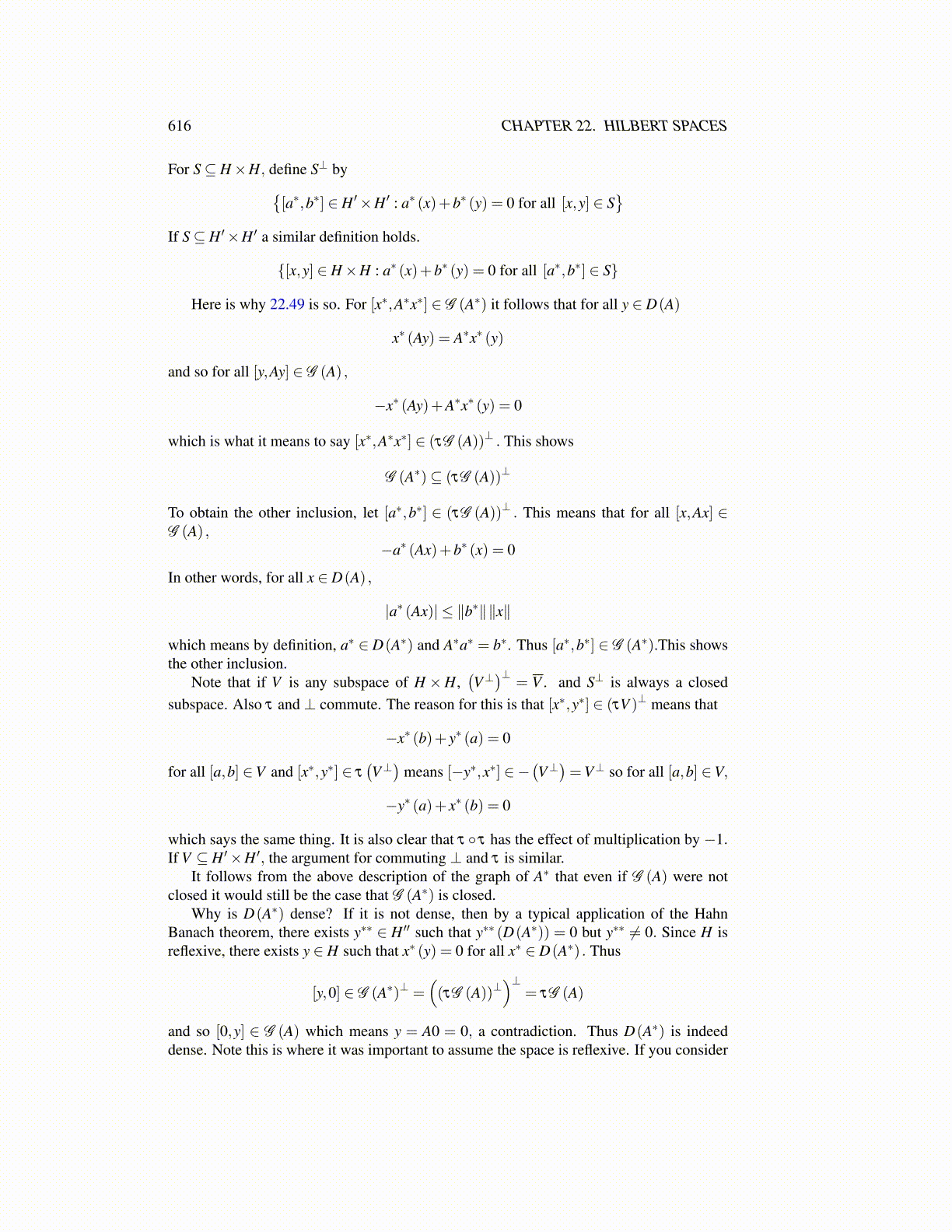
616 CHAPTER 22. HILBERT SPACES
For S⊆ H×H, define S⊥ by{[a∗,b∗] ∈ H ′×H ′ : a∗ (x)+b∗ (y) = 0 for all [x,y] ∈ S
}If S⊆ H ′×H ′ a similar definition holds.
{[x,y] ∈ H×H : a∗ (x)+b∗ (y) = 0 for all [a∗,b∗] ∈ S}
Here is why 22.49 is so. For [x∗,A∗x∗] ∈ G (A∗) it follows that for all y ∈ D(A)
x∗ (Ay) = A∗x∗ (y)
and so for all [y,Ay] ∈ G (A) ,
−x∗ (Ay)+A∗x∗ (y) = 0
which is what it means to say [x∗,A∗x∗] ∈ (τG (A))⊥ . This shows
G (A∗)⊆ (τG (A))⊥
To obtain the other inclusion, let [a∗,b∗] ∈ (τG (A))⊥ . This means that for all [x,Ax] ∈G (A) ,
−a∗ (Ax)+b∗ (x) = 0
In other words, for all x ∈ D(A) ,
|a∗ (Ax)| ≤ ∥b∗∥∥x∥
which means by definition, a∗ ∈ D(A∗) and A∗a∗ = b∗. Thus [a∗,b∗] ∈ G (A∗).This showsthe other inclusion.
Note that if V is any subspace of H ×H,(V⊥)⊥
= V . and S⊥ is always a closedsubspace. Also τ and ⊥ commute. The reason for this is that [x∗,y∗] ∈ (τV )⊥ means that
−x∗ (b)+ y∗ (a) = 0
for all [a,b] ∈V and [x∗,y∗] ∈ τ(V⊥)
means [−y∗,x∗] ∈ −(V⊥)=V⊥ so for all [a,b] ∈V,
−y∗ (a)+ x∗ (b) = 0
which says the same thing. It is also clear that τ ◦ τ has the effect of multiplication by −1.If V ⊆ H ′×H ′, the argument for commuting ⊥ and τ is similar.
It follows from the above description of the graph of A∗ that even if G (A) were notclosed it would still be the case that G (A∗) is closed.
Why is D(A∗) dense? If it is not dense, then by a typical application of the HahnBanach theorem, there exists y∗∗ ∈ H ′′ such that y∗∗ (D(A∗)) = 0 but y∗∗ ̸= 0. Since H isreflexive, there exists y ∈ H such that x∗ (y) = 0 for all x∗ ∈ D(A∗) . Thus
[y,0] ∈ G (A∗)⊥ =((τG (A))⊥
)⊥= τG (A)
and so [0,y] ∈ G (A) which means y = A0 = 0, a contradiction. Thus D(A∗) is indeeddense. Note this is where it was important to assume the space is reflexive. If you consider